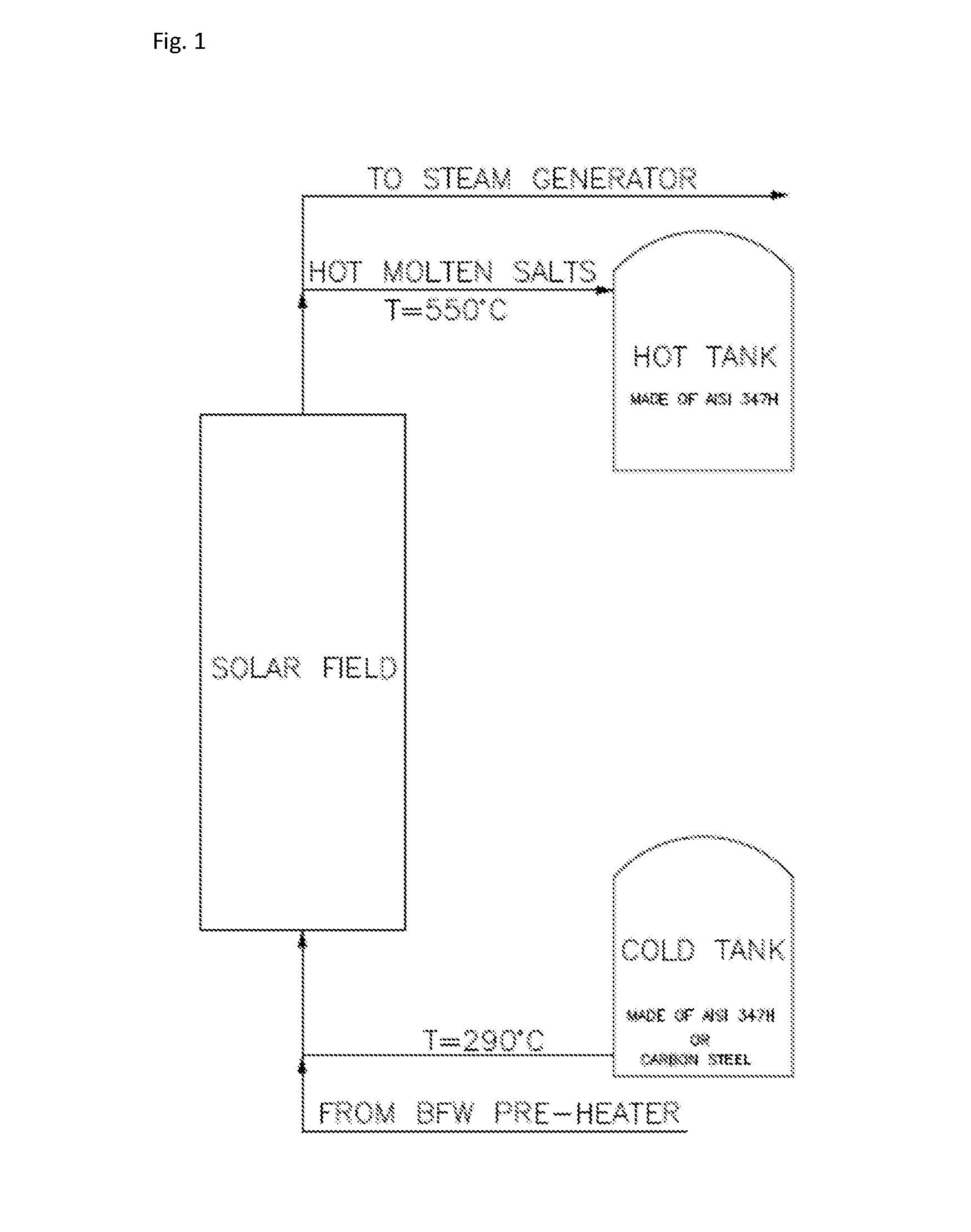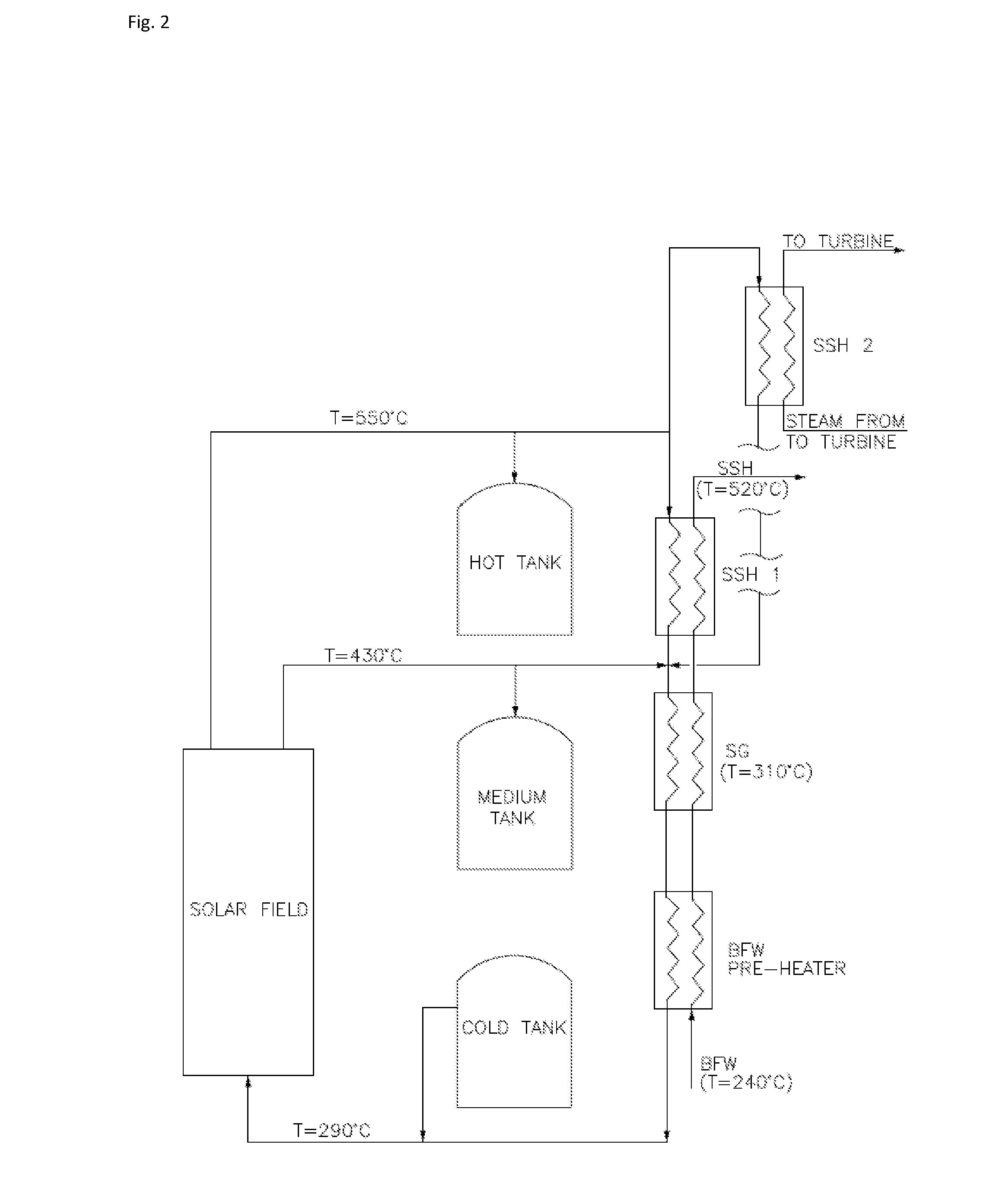Solar thermal energy storage system
a technology of solar thermal energy storage and solar energy, which is applied in the field of thermal energy storage systems, can solve the problems of limited disclosure of reservoirs
- Summary
- Abstract
- Description
- Claims
- Application Information
AI Technical Summary
Benefits of technology
Problems solved by technology
Method used
Image
Examples
example 1
[0060]In FIGS. 2 and 3 is shown an example of a proposed architecture for a solar plant of the invention, with reference to the phases of charging and discharging of molten salt, with and without steam reheating.
[0061]During the charging phase, FIG. 2, the hot MS streams from the solar field at 550° C. are used for:[0062]Filling the hot tank[0063]Superheating the steam, generating the high pressure steam and preheating the BFW[0064]Reheating the steam from the steam turbine (SSH2) meanwhile the 430° C. stream is used for;[0065]Filling the medium temperature tank[0066]Mixing with MS stream carrying from SSH1
[0067]MS circulating in the system is withdrawn from the cold tank where the MS was accumulated at the end of the discharging phase.
[0068]In FIG. 3, the hot MS flows through the SSH exchanger, is then mixed with MS stream at the outlet of SG before the BFW preheater. The MS flow at 450° C. enters the SG boiler where the high pressure steam is raised. After the BFW preheater the co...
example 2
[0071]This example refers to an architecture similar to that of Example 1. Here, however, a back-up boiler (FIG. 4) is provided to have a better control of steam temperature and steam flow to the steam turbine. This will allow to further maximize the Rankine cycle efficiency.
[0072]The back-up boiler typically is a fired heater where MS temperature before the SSH and / or the SG exchangers, is controlled by firing natural gas or any other gas or liquid fuel.
example 3
[0073]FIG. 5 shows a different configuration of the invention's architecture with 4 tanks, where two different tanks are used for the SSH purpose allowing to use the more expensive materials (steel grade “347H” in this case) only for the tank indicated as hot / hot tank, with a limited volume. In this case the hot tank is made in 316L and MT tank could be made of C-SA 335 carbon steel for instance. The hot / hot tank operates up to 585° C. Depending on the molten salts chosen, the same concept can also be used with a still higher temperature tank (up to, e.g., 800° C.).
[0074]In the proposed architecture MS streams are withdrawn from the solar field at: 430° C., 480° C. and 550° C., maximizing also the life of the receiver tubes and minimizing the high temperature stress to a small fraction of the Solar Field (SF) and the SF surface. The decoupling of the SSH duty can be also used when there is a need to reheat the steam from the steam turbine before a further subsequent expansion.
PUM
 Login to View More
Login to View More Abstract
Description
Claims
Application Information
 Login to View More
Login to View More - R&D
- Intellectual Property
- Life Sciences
- Materials
- Tech Scout
- Unparalleled Data Quality
- Higher Quality Content
- 60% Fewer Hallucinations
Browse by: Latest US Patents, China's latest patents, Technical Efficacy Thesaurus, Application Domain, Technology Topic, Popular Technical Reports.
© 2025 PatSnap. All rights reserved.Legal|Privacy policy|Modern Slavery Act Transparency Statement|Sitemap|About US| Contact US: help@patsnap.com



